Digital Disruption Case: Australia Post's Work Centred Analysis
VerifiedAdded on 2023/06/13
|14
|2863
|459
Case Study
AI Summary
This case study report employs the Work Centred Analysis (WCA) framework to examine the impact of digital disruption on Australia Post. It begins with a retrospective analysis of the company's operations before and after the digital shift, highlighting the challenges posed by declining mail volumes and the rise of e-commerce. The report identifies key problems, including the need for Australia Post to adapt to technological advancements and the potential for significant financial losses if it fails to do so. Assumptions are made based on available information, particularly regarding the effects of digital disruption on retail outlets, workforce adaptation, and customer priorities. The report then outlines the goals Australia Post has set to maintain its market position, such as pursuing new ventures, implementing tangible platforms, and investing in digital capabilities. Challenges associated with this transformation, including business obligations and the need for innovation, are discussed. The report concludes with recommendations for Australia Post to transform its operations into digital communication hubs and actively pursue new opportunities in the mail business, along with an implementation plan to support these recommendations.
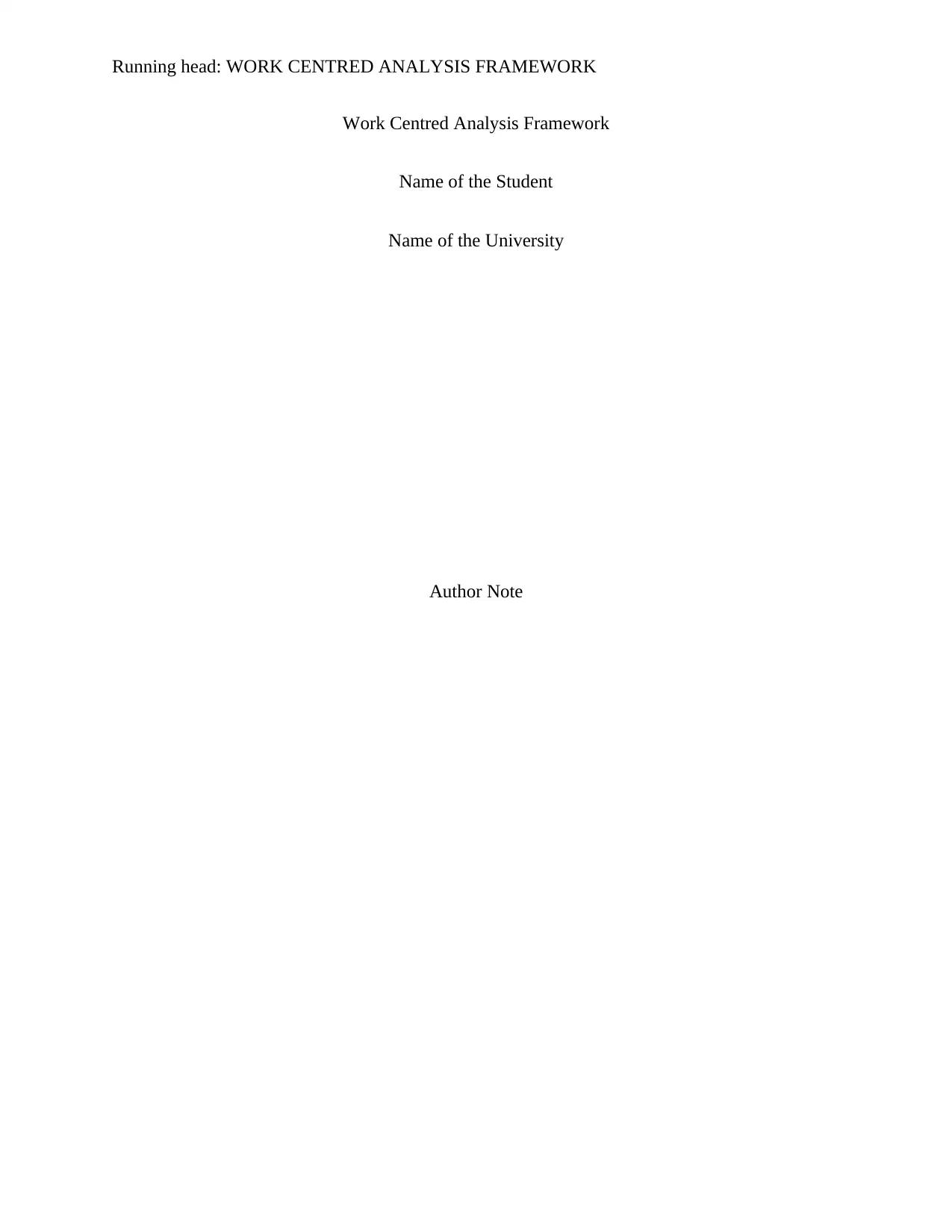
Running head: WORK CENTRED ANALYSIS FRAMEWORK
Work Centred Analysis Framework
Name of the Student
Name of the University
Author Note
Work Centred Analysis Framework
Name of the Student
Name of the University
Author Note
Paraphrase This Document
Need a fresh take? Get an instant paraphrase of this document with our AI Paraphraser
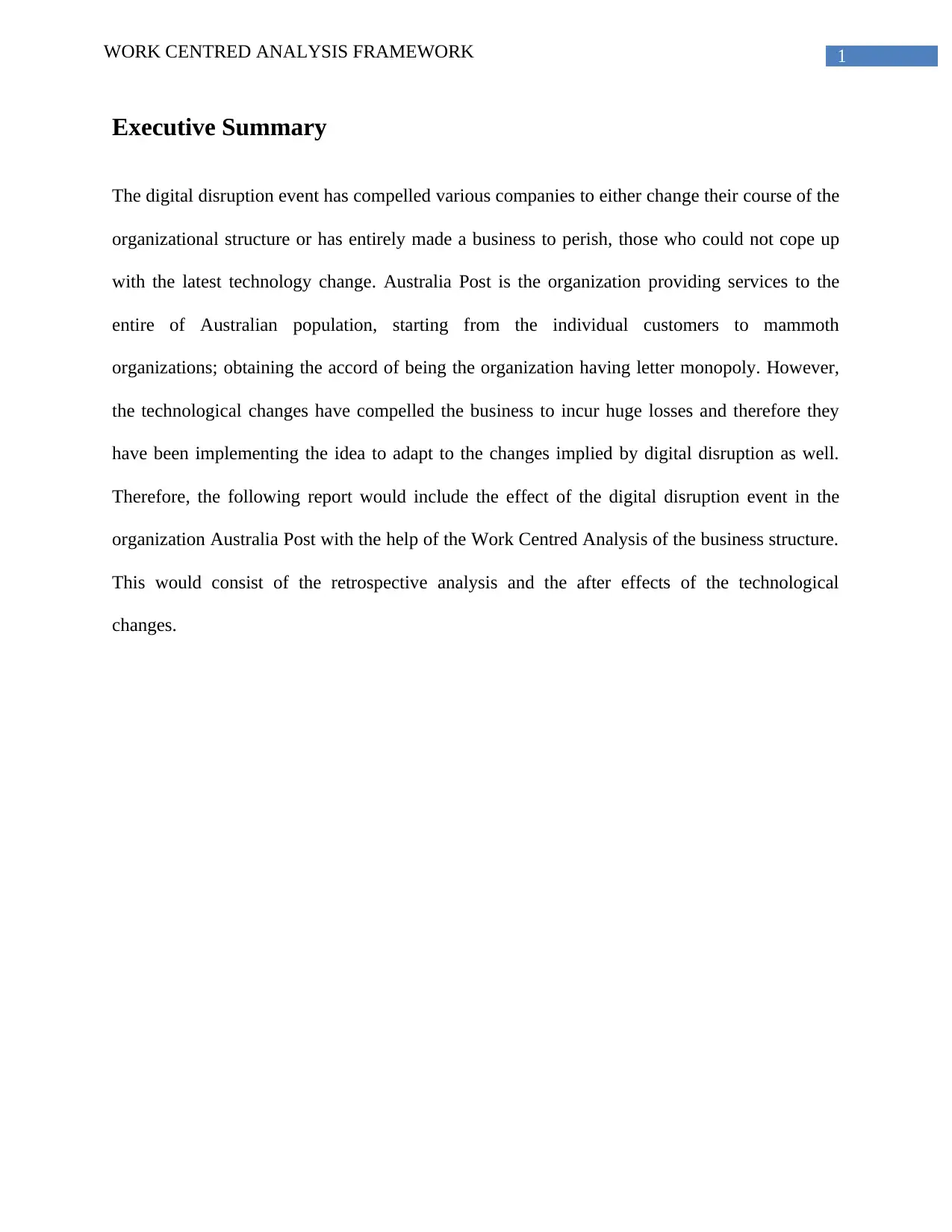
1WORK CENTRED ANALYSIS FRAMEWORK
Executive Summary
The digital disruption event has compelled various companies to either change their course of the
organizational structure or has entirely made a business to perish, those who could not cope up
with the latest technology change. Australia Post is the organization providing services to the
entire of Australian population, starting from the individual customers to mammoth
organizations; obtaining the accord of being the organization having letter monopoly. However,
the technological changes have compelled the business to incur huge losses and therefore they
have been implementing the idea to adapt to the changes implied by digital disruption as well.
Therefore, the following report would include the effect of the digital disruption event in the
organization Australia Post with the help of the Work Centred Analysis of the business structure.
This would consist of the retrospective analysis and the after effects of the technological
changes.
Executive Summary
The digital disruption event has compelled various companies to either change their course of the
organizational structure or has entirely made a business to perish, those who could not cope up
with the latest technology change. Australia Post is the organization providing services to the
entire of Australian population, starting from the individual customers to mammoth
organizations; obtaining the accord of being the organization having letter monopoly. However,
the technological changes have compelled the business to incur huge losses and therefore they
have been implementing the idea to adapt to the changes implied by digital disruption as well.
Therefore, the following report would include the effect of the digital disruption event in the
organization Australia Post with the help of the Work Centred Analysis of the business structure.
This would consist of the retrospective analysis and the after effects of the technological
changes.
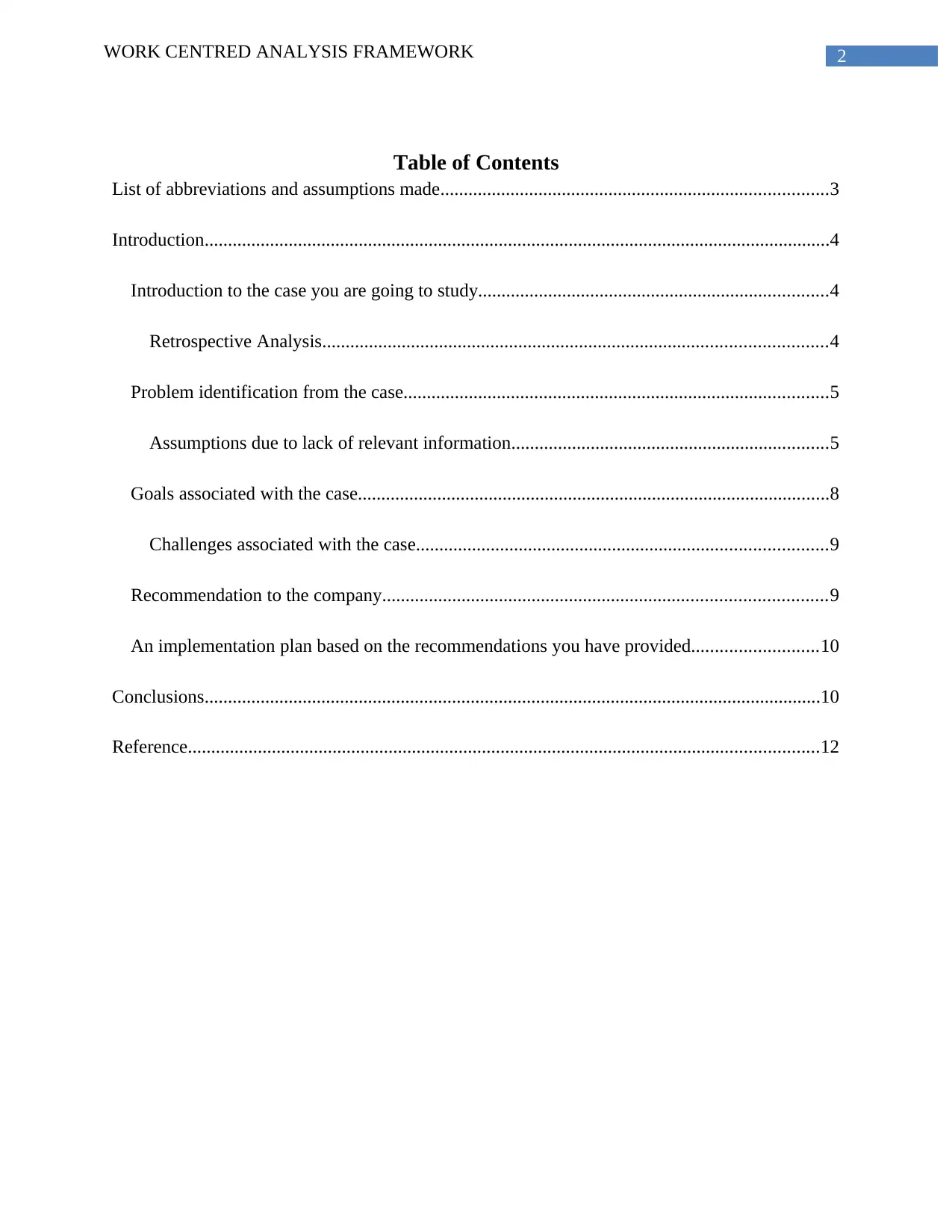
2WORK CENTRED ANALYSIS FRAMEWORK
Table of Contents
List of abbreviations and assumptions made...................................................................................3
Introduction......................................................................................................................................4
Introduction to the case you are going to study...........................................................................4
Retrospective Analysis............................................................................................................4
Problem identification from the case...........................................................................................5
Assumptions due to lack of relevant information....................................................................5
Goals associated with the case.....................................................................................................8
Challenges associated with the case........................................................................................9
Recommendation to the company...............................................................................................9
An implementation plan based on the recommendations you have provided...........................10
Conclusions....................................................................................................................................10
Reference.......................................................................................................................................12
Table of Contents
List of abbreviations and assumptions made...................................................................................3
Introduction......................................................................................................................................4
Introduction to the case you are going to study...........................................................................4
Retrospective Analysis............................................................................................................4
Problem identification from the case...........................................................................................5
Assumptions due to lack of relevant information....................................................................5
Goals associated with the case.....................................................................................................8
Challenges associated with the case........................................................................................9
Recommendation to the company...............................................................................................9
An implementation plan based on the recommendations you have provided...........................10
Conclusions....................................................................................................................................10
Reference.......................................................................................................................................12
⊘ This is a preview!⊘
Do you want full access?
Subscribe today to unlock all pages.

Trusted by 1+ million students worldwide
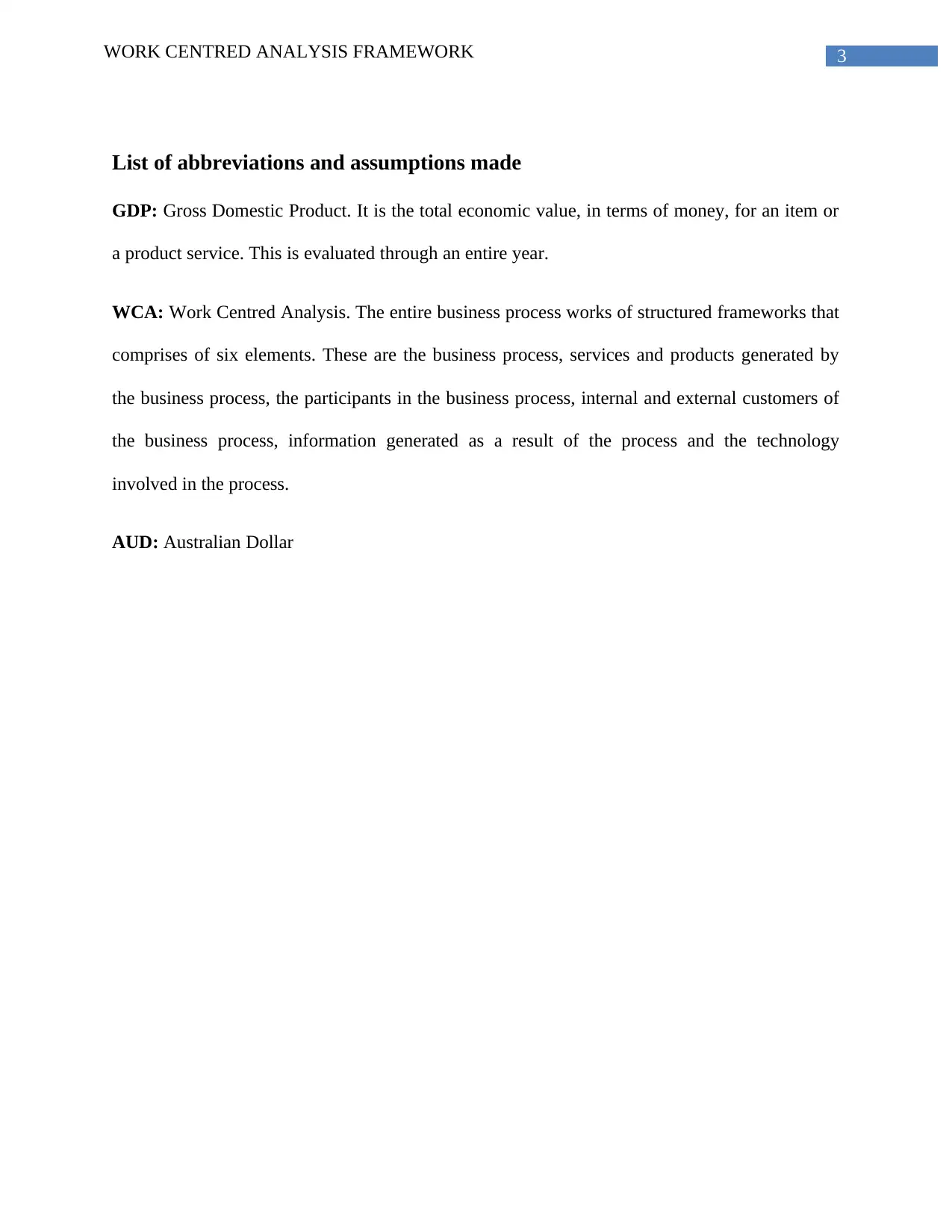
3WORK CENTRED ANALYSIS FRAMEWORK
List of abbreviations and assumptions made
GDP: Gross Domestic Product. It is the total economic value, in terms of money, for an item or
a product service. This is evaluated through an entire year.
WCA: Work Centred Analysis. The entire business process works of structured frameworks that
comprises of six elements. These are the business process, services and products generated by
the business process, the participants in the business process, internal and external customers of
the business process, information generated as a result of the process and the technology
involved in the process.
AUD: Australian Dollar
List of abbreviations and assumptions made
GDP: Gross Domestic Product. It is the total economic value, in terms of money, for an item or
a product service. This is evaluated through an entire year.
WCA: Work Centred Analysis. The entire business process works of structured frameworks that
comprises of six elements. These are the business process, services and products generated by
the business process, the participants in the business process, internal and external customers of
the business process, information generated as a result of the process and the technology
involved in the process.
AUD: Australian Dollar
Paraphrase This Document
Need a fresh take? Get an instant paraphrase of this document with our AI Paraphraser
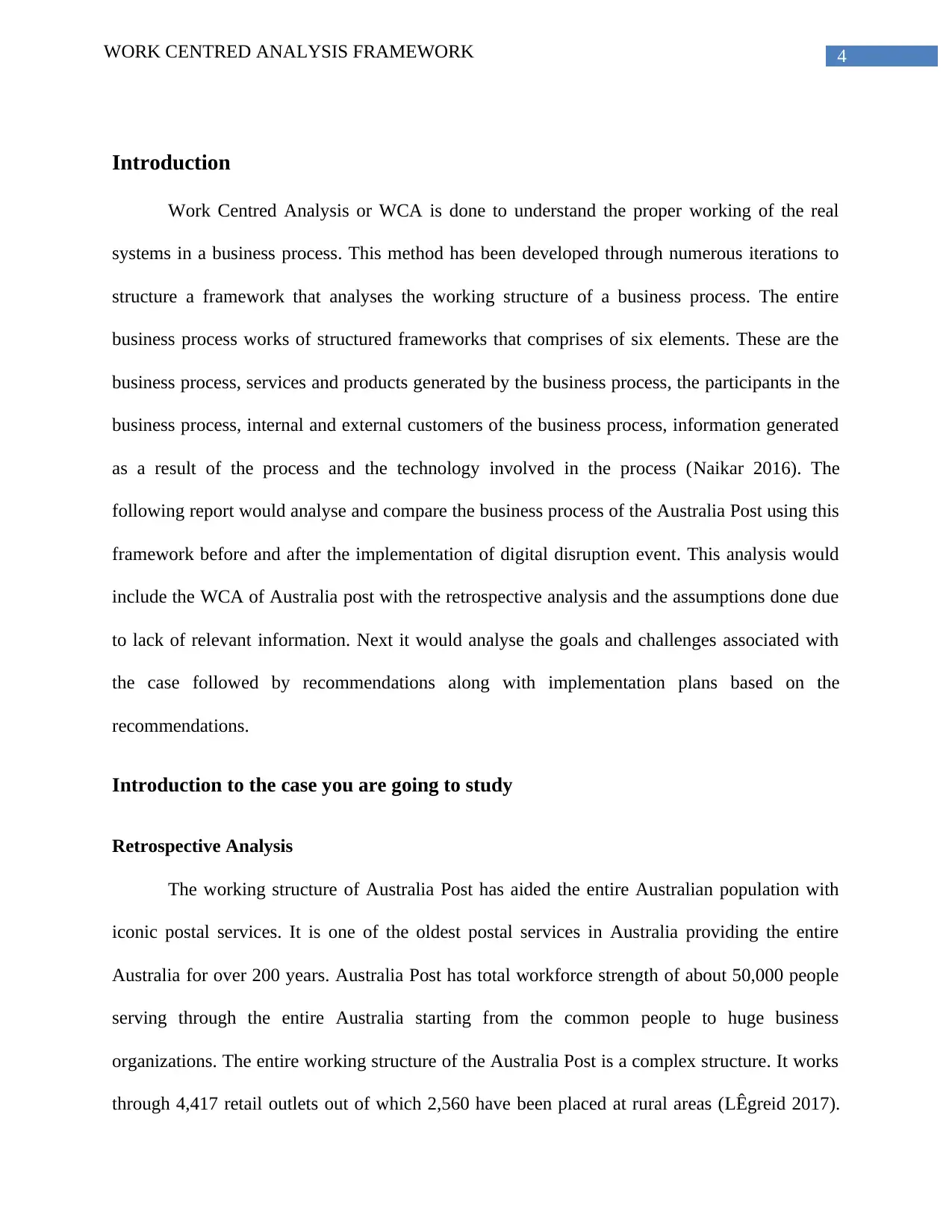
4WORK CENTRED ANALYSIS FRAMEWORK
Introduction
Work Centred Analysis or WCA is done to understand the proper working of the real
systems in a business process. This method has been developed through numerous iterations to
structure a framework that analyses the working structure of a business process. The entire
business process works of structured frameworks that comprises of six elements. These are the
business process, services and products generated by the business process, the participants in the
business process, internal and external customers of the business process, information generated
as a result of the process and the technology involved in the process (Naikar 2016). The
following report would analyse and compare the business process of the Australia Post using this
framework before and after the implementation of digital disruption event. This analysis would
include the WCA of Australia post with the retrospective analysis and the assumptions done due
to lack of relevant information. Next it would analyse the goals and challenges associated with
the case followed by recommendations along with implementation plans based on the
recommendations.
Introduction to the case you are going to study
Retrospective Analysis
The working structure of Australia Post has aided the entire Australian population with
iconic postal services. It is one of the oldest postal services in Australia providing the entire
Australia for over 200 years. Australia Post has total workforce strength of about 50,000 people
serving through the entire Australia starting from the common people to huge business
organizations. The entire working structure of the Australia Post is a complex structure. It works
through 4,417 retail outlets out of which 2,560 have been placed at rural areas (LÊgreid 2017).
Introduction
Work Centred Analysis or WCA is done to understand the proper working of the real
systems in a business process. This method has been developed through numerous iterations to
structure a framework that analyses the working structure of a business process. The entire
business process works of structured frameworks that comprises of six elements. These are the
business process, services and products generated by the business process, the participants in the
business process, internal and external customers of the business process, information generated
as a result of the process and the technology involved in the process (Naikar 2016). The
following report would analyse and compare the business process of the Australia Post using this
framework before and after the implementation of digital disruption event. This analysis would
include the WCA of Australia post with the retrospective analysis and the assumptions done due
to lack of relevant information. Next it would analyse the goals and challenges associated with
the case followed by recommendations along with implementation plans based on the
recommendations.
Introduction to the case you are going to study
Retrospective Analysis
The working structure of Australia Post has aided the entire Australian population with
iconic postal services. It is one of the oldest postal services in Australia providing the entire
Australia for over 200 years. Australia Post has total workforce strength of about 50,000 people
serving through the entire Australia starting from the common people to huge business
organizations. The entire working structure of the Australia Post is a complex structure. It works
through 4,417 retail outlets out of which 2,560 have been placed at rural areas (LÊgreid 2017).
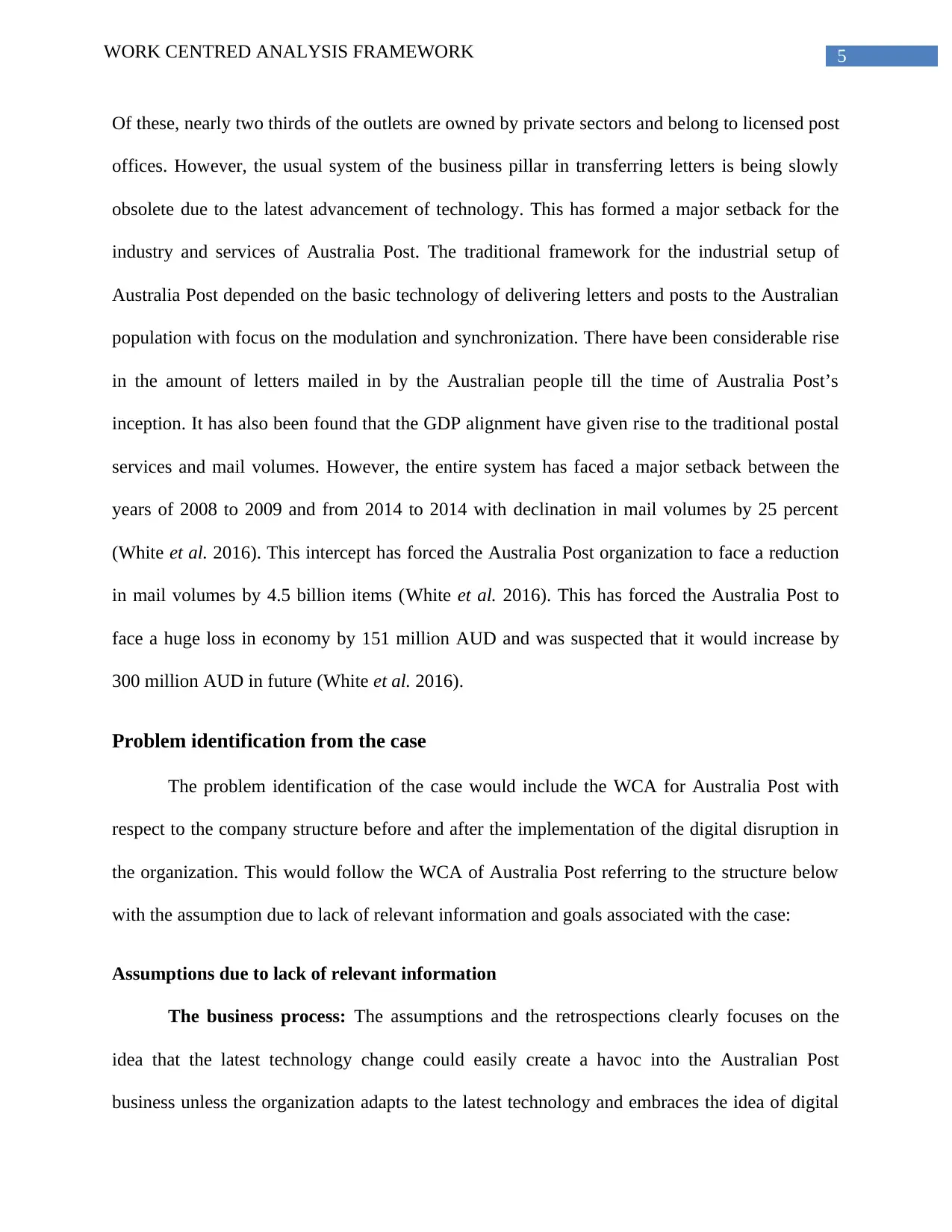
5WORK CENTRED ANALYSIS FRAMEWORK
Of these, nearly two thirds of the outlets are owned by private sectors and belong to licensed post
offices. However, the usual system of the business pillar in transferring letters is being slowly
obsolete due to the latest advancement of technology. This has formed a major setback for the
industry and services of Australia Post. The traditional framework for the industrial setup of
Australia Post depended on the basic technology of delivering letters and posts to the Australian
population with focus on the modulation and synchronization. There have been considerable rise
in the amount of letters mailed in by the Australian people till the time of Australia Post’s
inception. It has also been found that the GDP alignment have given rise to the traditional postal
services and mail volumes. However, the entire system has faced a major setback between the
years of 2008 to 2009 and from 2014 to 2014 with declination in mail volumes by 25 percent
(White et al. 2016). This intercept has forced the Australia Post organization to face a reduction
in mail volumes by 4.5 billion items (White et al. 2016). This has forced the Australia Post to
face a huge loss in economy by 151 million AUD and was suspected that it would increase by
300 million AUD in future (White et al. 2016).
Problem identification from the case
The problem identification of the case would include the WCA for Australia Post with
respect to the company structure before and after the implementation of the digital disruption in
the organization. This would follow the WCA of Australia Post referring to the structure below
with the assumption due to lack of relevant information and goals associated with the case:
Assumptions due to lack of relevant information
The business process: The assumptions and the retrospections clearly focuses on the
idea that the latest technology change could easily create a havoc into the Australian Post
business unless the organization adapts to the latest technology and embraces the idea of digital
Of these, nearly two thirds of the outlets are owned by private sectors and belong to licensed post
offices. However, the usual system of the business pillar in transferring letters is being slowly
obsolete due to the latest advancement of technology. This has formed a major setback for the
industry and services of Australia Post. The traditional framework for the industrial setup of
Australia Post depended on the basic technology of delivering letters and posts to the Australian
population with focus on the modulation and synchronization. There have been considerable rise
in the amount of letters mailed in by the Australian people till the time of Australia Post’s
inception. It has also been found that the GDP alignment have given rise to the traditional postal
services and mail volumes. However, the entire system has faced a major setback between the
years of 2008 to 2009 and from 2014 to 2014 with declination in mail volumes by 25 percent
(White et al. 2016). This intercept has forced the Australia Post organization to face a reduction
in mail volumes by 4.5 billion items (White et al. 2016). This has forced the Australia Post to
face a huge loss in economy by 151 million AUD and was suspected that it would increase by
300 million AUD in future (White et al. 2016).
Problem identification from the case
The problem identification of the case would include the WCA for Australia Post with
respect to the company structure before and after the implementation of the digital disruption in
the organization. This would follow the WCA of Australia Post referring to the structure below
with the assumption due to lack of relevant information and goals associated with the case:
Assumptions due to lack of relevant information
The business process: The assumptions and the retrospections clearly focuses on the
idea that the latest technology change could easily create a havoc into the Australian Post
business unless the organization adapts to the latest technology and embraces the idea of digital
⊘ This is a preview!⊘
Do you want full access?
Subscribe today to unlock all pages.

Trusted by 1+ million students worldwide
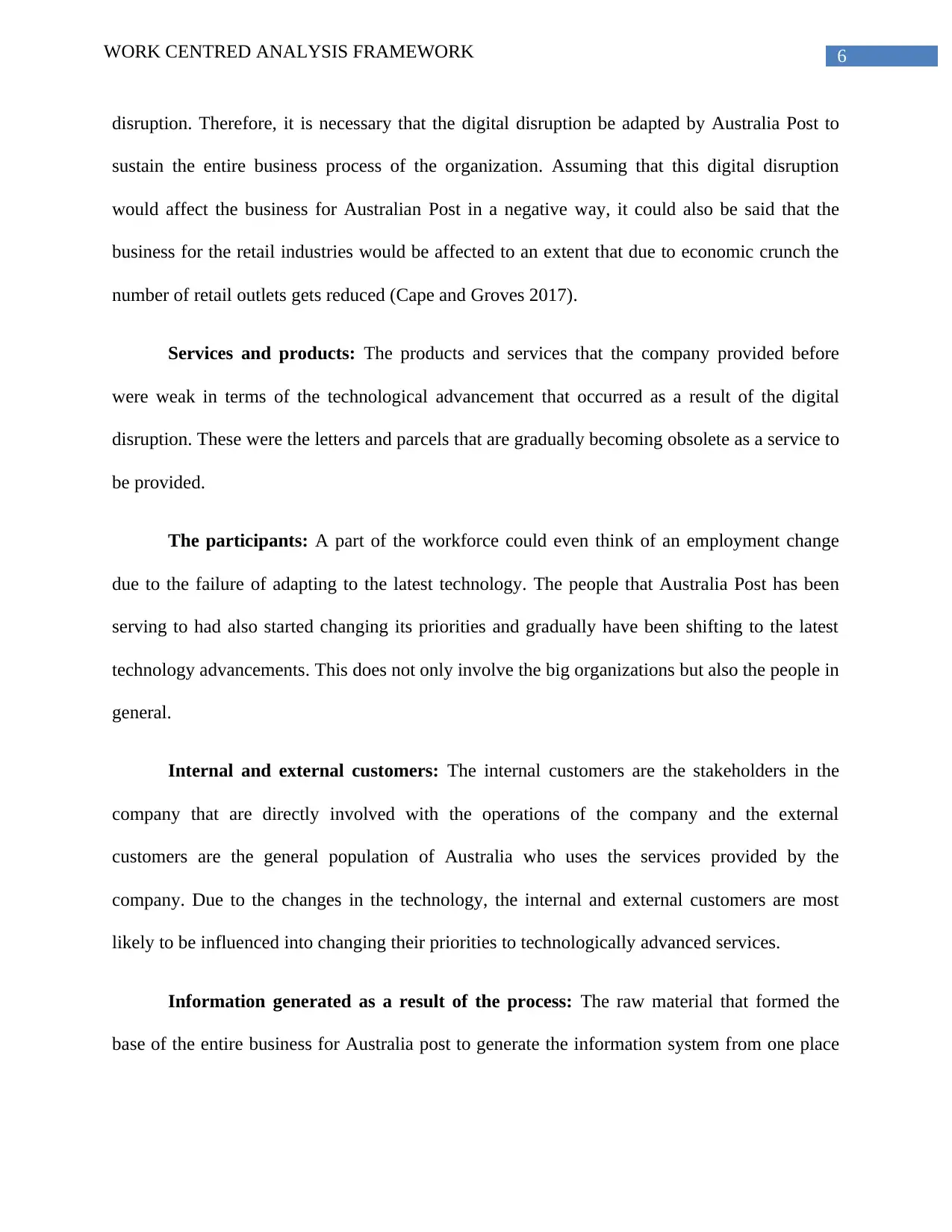
6WORK CENTRED ANALYSIS FRAMEWORK
disruption. Therefore, it is necessary that the digital disruption be adapted by Australia Post to
sustain the entire business process of the organization. Assuming that this digital disruption
would affect the business for Australian Post in a negative way, it could also be said that the
business for the retail industries would be affected to an extent that due to economic crunch the
number of retail outlets gets reduced (Cape and Groves 2017).
Services and products: The products and services that the company provided before
were weak in terms of the technological advancement that occurred as a result of the digital
disruption. These were the letters and parcels that are gradually becoming obsolete as a service to
be provided.
The participants: A part of the workforce could even think of an employment change
due to the failure of adapting to the latest technology. The people that Australia Post has been
serving to had also started changing its priorities and gradually have been shifting to the latest
technology advancements. This does not only involve the big organizations but also the people in
general.
Internal and external customers: The internal customers are the stakeholders in the
company that are directly involved with the operations of the company and the external
customers are the general population of Australia who uses the services provided by the
company. Due to the changes in the technology, the internal and external customers are most
likely to be influenced into changing their priorities to technologically advanced services.
Information generated as a result of the process: The raw material that formed the
base of the entire business for Australia post to generate the information system from one place
disruption. Therefore, it is necessary that the digital disruption be adapted by Australia Post to
sustain the entire business process of the organization. Assuming that this digital disruption
would affect the business for Australian Post in a negative way, it could also be said that the
business for the retail industries would be affected to an extent that due to economic crunch the
number of retail outlets gets reduced (Cape and Groves 2017).
Services and products: The products and services that the company provided before
were weak in terms of the technological advancement that occurred as a result of the digital
disruption. These were the letters and parcels that are gradually becoming obsolete as a service to
be provided.
The participants: A part of the workforce could even think of an employment change
due to the failure of adapting to the latest technology. The people that Australia Post has been
serving to had also started changing its priorities and gradually have been shifting to the latest
technology advancements. This does not only involve the big organizations but also the people in
general.
Internal and external customers: The internal customers are the stakeholders in the
company that are directly involved with the operations of the company and the external
customers are the general population of Australia who uses the services provided by the
company. Due to the changes in the technology, the internal and external customers are most
likely to be influenced into changing their priorities to technologically advanced services.
Information generated as a result of the process: The raw material that formed the
base of the entire business for Australia post to generate the information system from one place
Paraphrase This Document
Need a fresh take? Get an instant paraphrase of this document with our AI Paraphraser
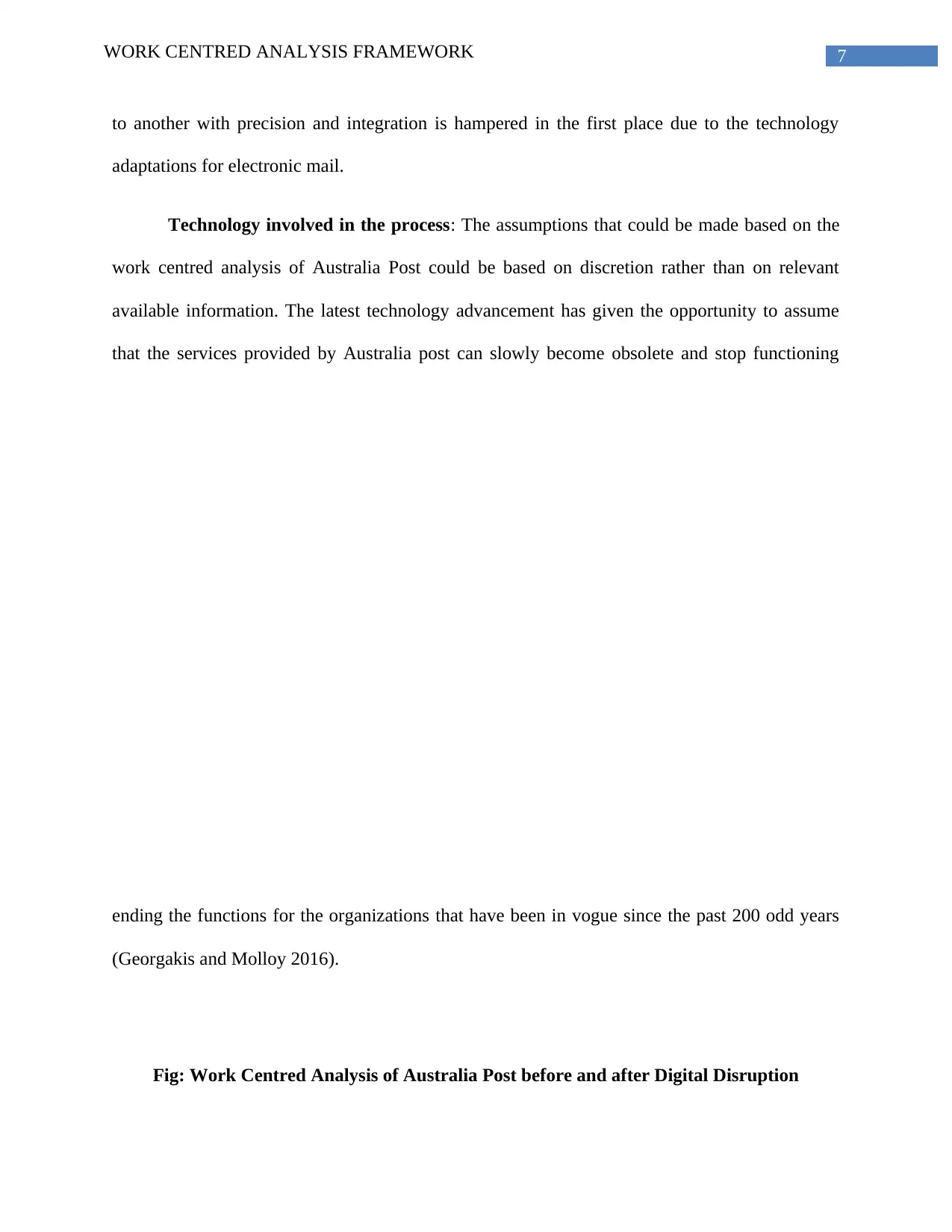
7WORK CENTRED ANALYSIS FRAMEWORK
to another with precision and integration is hampered in the first place due to the technology
adaptations for electronic mail.
Technology involved in the process: The assumptions that could be made based on the
work centred analysis of Australia Post could be based on discretion rather than on relevant
available information. The latest technology advancement has given the opportunity to assume
that the services provided by Australia post can slowly become obsolete and stop functioning
ending the functions for the organizations that have been in vogue since the past 200 odd years
(Georgakis and Molloy 2016).
Fig: Work Centred Analysis of Australia Post before and after Digital Disruption
to another with precision and integration is hampered in the first place due to the technology
adaptations for electronic mail.
Technology involved in the process: The assumptions that could be made based on the
work centred analysis of Australia Post could be based on discretion rather than on relevant
available information. The latest technology advancement has given the opportunity to assume
that the services provided by Australia post can slowly become obsolete and stop functioning
ending the functions for the organizations that have been in vogue since the past 200 odd years
(Georgakis and Molloy 2016).
Fig: Work Centred Analysis of Australia Post before and after Digital Disruption
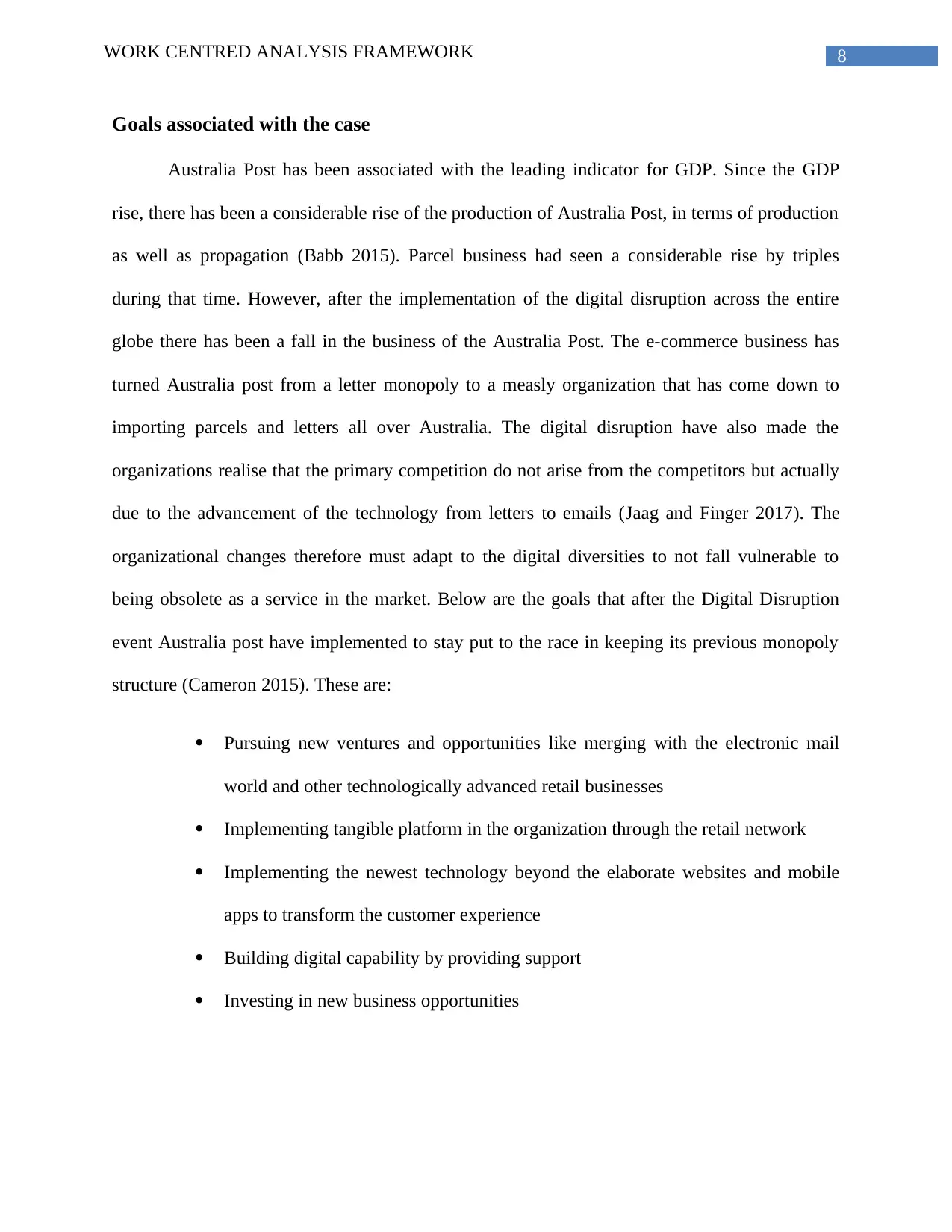
8WORK CENTRED ANALYSIS FRAMEWORK
Goals associated with the case
Australia Post has been associated with the leading indicator for GDP. Since the GDP
rise, there has been a considerable rise of the production of Australia Post, in terms of production
as well as propagation (Babb 2015). Parcel business had seen a considerable rise by triples
during that time. However, after the implementation of the digital disruption across the entire
globe there has been a fall in the business of the Australia Post. The e-commerce business has
turned Australia post from a letter monopoly to a measly organization that has come down to
importing parcels and letters all over Australia. The digital disruption have also made the
organizations realise that the primary competition do not arise from the competitors but actually
due to the advancement of the technology from letters to emails (Jaag and Finger 2017). The
organizational changes therefore must adapt to the digital diversities to not fall vulnerable to
being obsolete as a service in the market. Below are the goals that after the Digital Disruption
event Australia post have implemented to stay put to the race in keeping its previous monopoly
structure (Cameron 2015). These are:
Pursuing new ventures and opportunities like merging with the electronic mail
world and other technologically advanced retail businesses
Implementing tangible platform in the organization through the retail network
Implementing the newest technology beyond the elaborate websites and mobile
apps to transform the customer experience
Building digital capability by providing support
Investing in new business opportunities
Goals associated with the case
Australia Post has been associated with the leading indicator for GDP. Since the GDP
rise, there has been a considerable rise of the production of Australia Post, in terms of production
as well as propagation (Babb 2015). Parcel business had seen a considerable rise by triples
during that time. However, after the implementation of the digital disruption across the entire
globe there has been a fall in the business of the Australia Post. The e-commerce business has
turned Australia post from a letter monopoly to a measly organization that has come down to
importing parcels and letters all over Australia. The digital disruption have also made the
organizations realise that the primary competition do not arise from the competitors but actually
due to the advancement of the technology from letters to emails (Jaag and Finger 2017). The
organizational changes therefore must adapt to the digital diversities to not fall vulnerable to
being obsolete as a service in the market. Below are the goals that after the Digital Disruption
event Australia post have implemented to stay put to the race in keeping its previous monopoly
structure (Cameron 2015). These are:
Pursuing new ventures and opportunities like merging with the electronic mail
world and other technologically advanced retail businesses
Implementing tangible platform in the organization through the retail network
Implementing the newest technology beyond the elaborate websites and mobile
apps to transform the customer experience
Building digital capability by providing support
Investing in new business opportunities
⊘ This is a preview!⊘
Do you want full access?
Subscribe today to unlock all pages.

Trusted by 1+ million students worldwide
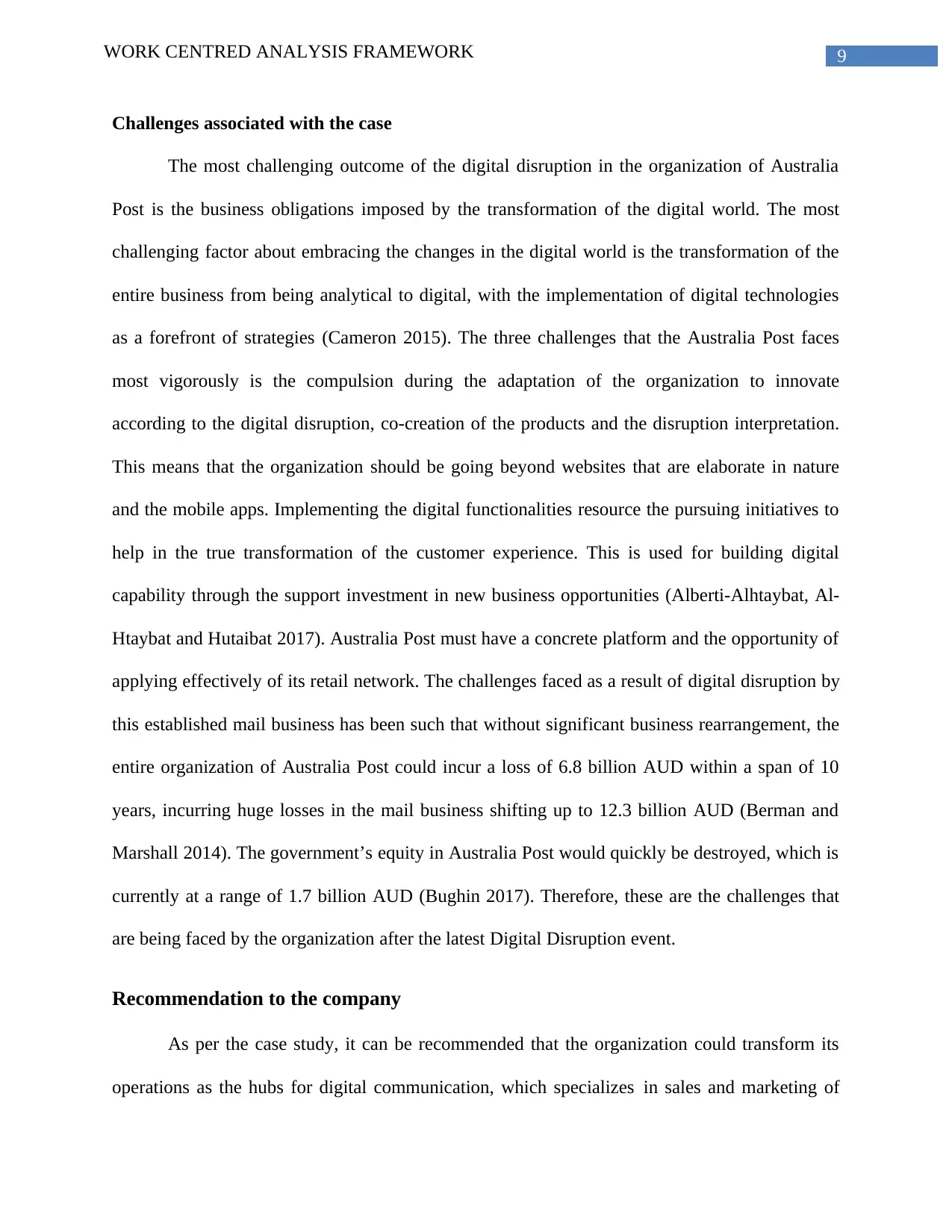
9WORK CENTRED ANALYSIS FRAMEWORK
Challenges associated with the case
The most challenging outcome of the digital disruption in the organization of Australia
Post is the business obligations imposed by the transformation of the digital world. The most
challenging factor about embracing the changes in the digital world is the transformation of the
entire business from being analytical to digital, with the implementation of digital technologies
as a forefront of strategies (Cameron 2015). The three challenges that the Australia Post faces
most vigorously is the compulsion during the adaptation of the organization to innovate
according to the digital disruption, co-creation of the products and the disruption interpretation.
This means that the organization should be going beyond websites that are elaborate in nature
and the mobile apps. Implementing the digital functionalities resource the pursuing initiatives to
help in the true transformation of the customer experience. This is used for building digital
capability through the support investment in new business opportunities (Alberti-Alhtaybat, Al-
Htaybat and Hutaibat 2017). Australia Post must have a concrete platform and the opportunity of
applying effectively of its retail network. The challenges faced as a result of digital disruption by
this established mail business has been such that without significant business rearrangement, the
entire organization of Australia Post could incur a loss of 6.8 billion AUD within a span of 10
years, incurring huge losses in the mail business shifting up to 12.3 billion AUD (Berman and
Marshall 2014). The government’s equity in Australia Post would quickly be destroyed, which is
currently at a range of 1.7 billion AUD (Bughin 2017). Therefore, these are the challenges that
are being faced by the organization after the latest Digital Disruption event.
Recommendation to the company
As per the case study, it can be recommended that the organization could transform its
operations as the hubs for digital communication, which specializes in sales and marketing of
Challenges associated with the case
The most challenging outcome of the digital disruption in the organization of Australia
Post is the business obligations imposed by the transformation of the digital world. The most
challenging factor about embracing the changes in the digital world is the transformation of the
entire business from being analytical to digital, with the implementation of digital technologies
as a forefront of strategies (Cameron 2015). The three challenges that the Australia Post faces
most vigorously is the compulsion during the adaptation of the organization to innovate
according to the digital disruption, co-creation of the products and the disruption interpretation.
This means that the organization should be going beyond websites that are elaborate in nature
and the mobile apps. Implementing the digital functionalities resource the pursuing initiatives to
help in the true transformation of the customer experience. This is used for building digital
capability through the support investment in new business opportunities (Alberti-Alhtaybat, Al-
Htaybat and Hutaibat 2017). Australia Post must have a concrete platform and the opportunity of
applying effectively of its retail network. The challenges faced as a result of digital disruption by
this established mail business has been such that without significant business rearrangement, the
entire organization of Australia Post could incur a loss of 6.8 billion AUD within a span of 10
years, incurring huge losses in the mail business shifting up to 12.3 billion AUD (Berman and
Marshall 2014). The government’s equity in Australia Post would quickly be destroyed, which is
currently at a range of 1.7 billion AUD (Bughin 2017). Therefore, these are the challenges that
are being faced by the organization after the latest Digital Disruption event.
Recommendation to the company
As per the case study, it can be recommended that the organization could transform its
operations as the hubs for digital communication, which specializes in sales and marketing of
Paraphrase This Document
Need a fresh take? Get an instant paraphrase of this document with our AI Paraphraser
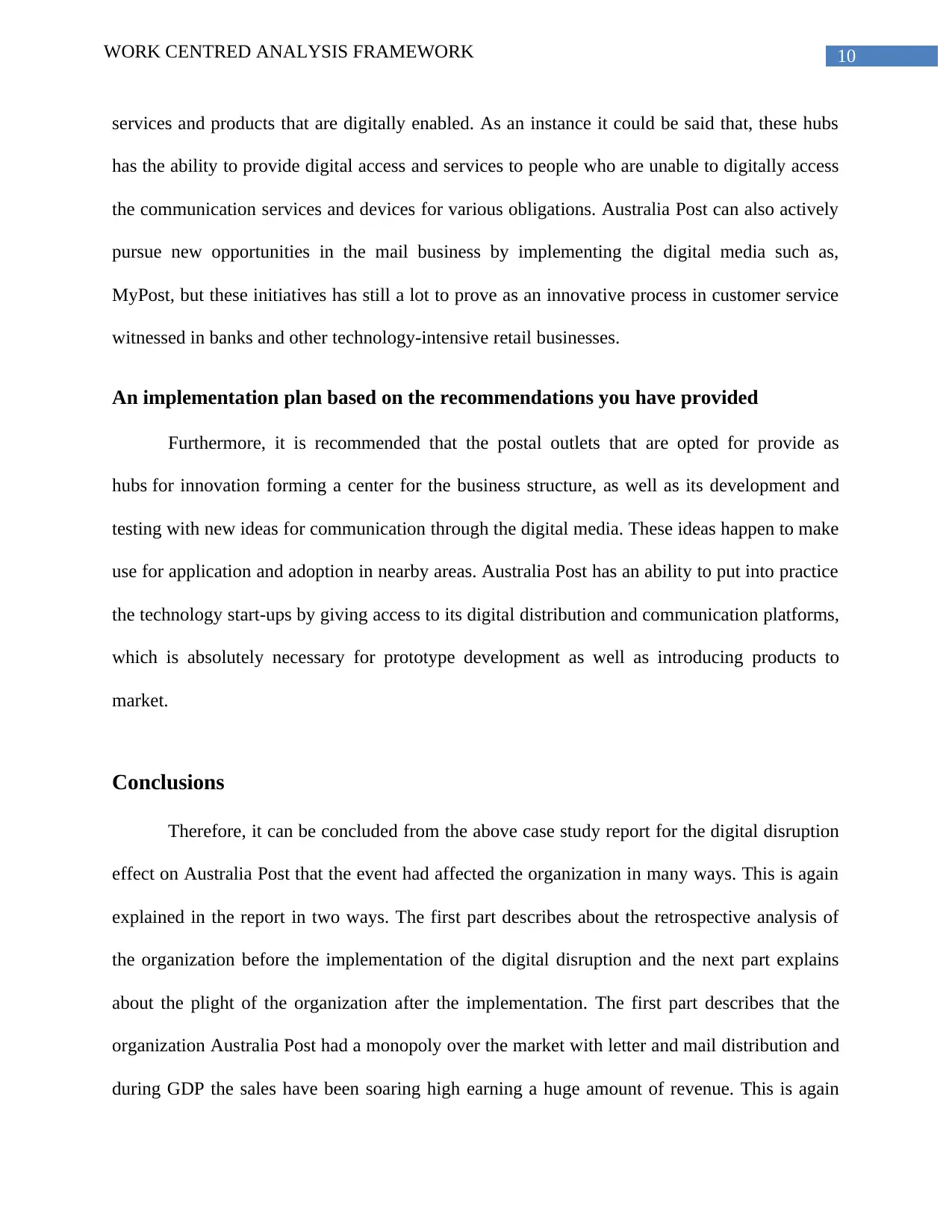
10WORK CENTRED ANALYSIS FRAMEWORK
services and products that are digitally enabled. As an instance it could be said that, these hubs
has the ability to provide digital access and services to people who are unable to digitally access
the communication services and devices for various obligations. Australia Post can also actively
pursue new opportunities in the mail business by implementing the digital media such as,
MyPost, but these initiatives has still a lot to prove as an innovative process in customer service
witnessed in banks and other technology-intensive retail businesses.
An implementation plan based on the recommendations you have provided
Furthermore, it is recommended that the postal outlets that are opted for provide as
hubs for innovation forming a center for the business structure, as well as its development and
testing with new ideas for communication through the digital media. These ideas happen to make
use for application and adoption in nearby areas. Australia Post has an ability to put into practice
the technology start-ups by giving access to its digital distribution and communication platforms,
which is absolutely necessary for prototype development as well as introducing products to
market.
Conclusions
Therefore, it can be concluded from the above case study report for the digital disruption
effect on Australia Post that the event had affected the organization in many ways. This is again
explained in the report in two ways. The first part describes about the retrospective analysis of
the organization before the implementation of the digital disruption and the next part explains
about the plight of the organization after the implementation. The first part describes that the
organization Australia Post had a monopoly over the market with letter and mail distribution and
during GDP the sales have been soaring high earning a huge amount of revenue. This is again
services and products that are digitally enabled. As an instance it could be said that, these hubs
has the ability to provide digital access and services to people who are unable to digitally access
the communication services and devices for various obligations. Australia Post can also actively
pursue new opportunities in the mail business by implementing the digital media such as,
MyPost, but these initiatives has still a lot to prove as an innovative process in customer service
witnessed in banks and other technology-intensive retail businesses.
An implementation plan based on the recommendations you have provided
Furthermore, it is recommended that the postal outlets that are opted for provide as
hubs for innovation forming a center for the business structure, as well as its development and
testing with new ideas for communication through the digital media. These ideas happen to make
use for application and adoption in nearby areas. Australia Post has an ability to put into practice
the technology start-ups by giving access to its digital distribution and communication platforms,
which is absolutely necessary for prototype development as well as introducing products to
market.
Conclusions
Therefore, it can be concluded from the above case study report for the digital disruption
effect on Australia Post that the event had affected the organization in many ways. This is again
explained in the report in two ways. The first part describes about the retrospective analysis of
the organization before the implementation of the digital disruption and the next part explains
about the plight of the organization after the implementation. The first part describes that the
organization Australia Post had a monopoly over the market with letter and mail distribution and
during GDP the sales have been soaring high earning a huge amount of revenue. This is again
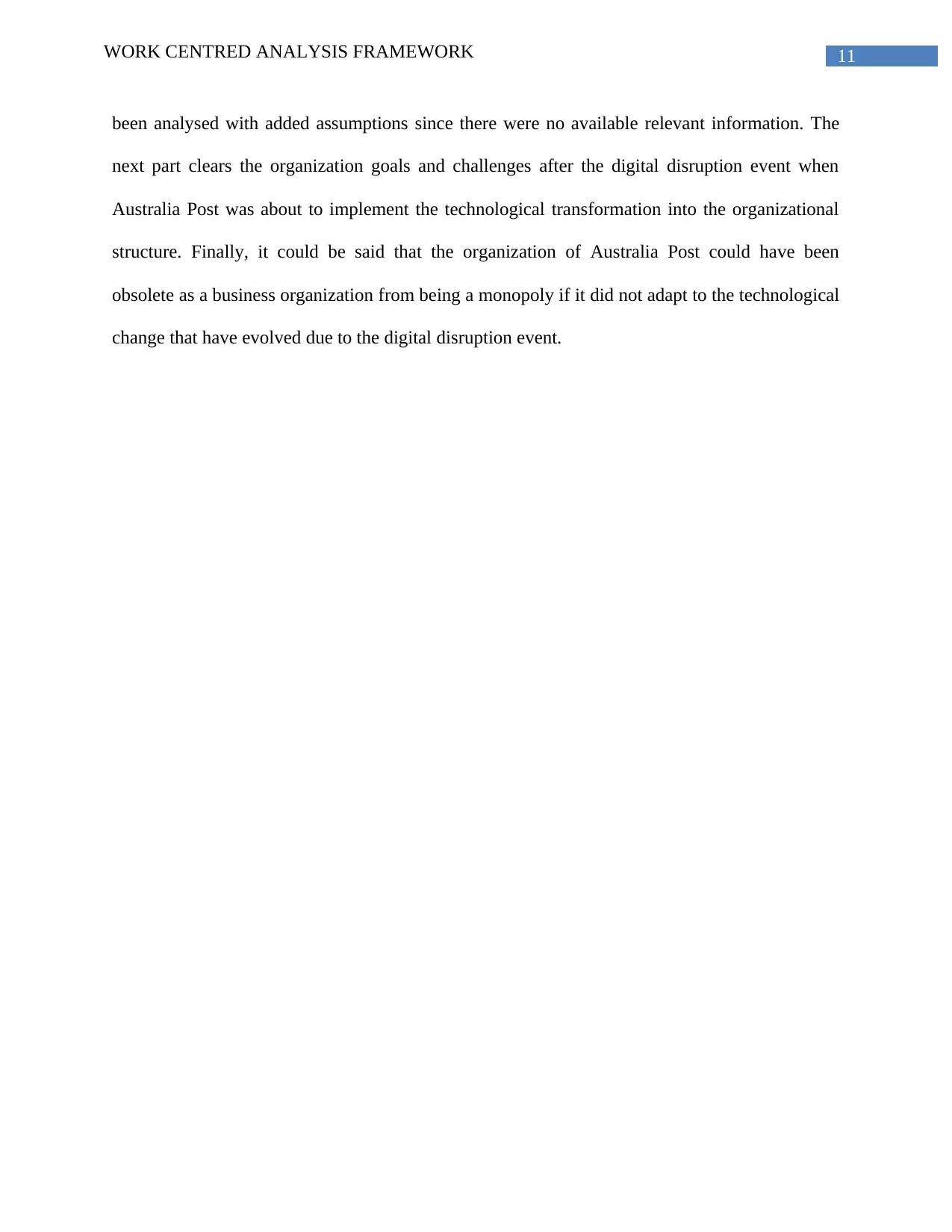
11WORK CENTRED ANALYSIS FRAMEWORK
been analysed with added assumptions since there were no available relevant information. The
next part clears the organization goals and challenges after the digital disruption event when
Australia Post was about to implement the technological transformation into the organizational
structure. Finally, it could be said that the organization of Australia Post could have been
obsolete as a business organization from being a monopoly if it did not adapt to the technological
change that have evolved due to the digital disruption event.
been analysed with added assumptions since there were no available relevant information. The
next part clears the organization goals and challenges after the digital disruption event when
Australia Post was about to implement the technological transformation into the organizational
structure. Finally, it could be said that the organization of Australia Post could have been
obsolete as a business organization from being a monopoly if it did not adapt to the technological
change that have evolved due to the digital disruption event.
⊘ This is a preview!⊘
Do you want full access?
Subscribe today to unlock all pages.

Trusted by 1+ million students worldwide
1 out of 14
Related Documents
Your All-in-One AI-Powered Toolkit for Academic Success.
+13062052269
info@desklib.com
Available 24*7 on WhatsApp / Email
![[object Object]](/_next/static/media/star-bottom.7253800d.svg)
Unlock your academic potential
Copyright © 2020–2025 A2Z Services. All Rights Reserved. Developed and managed by ZUCOL.





